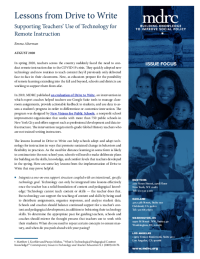Lessons from Drive to Write
Supporting Teachers’ Use of Technology for Remote Instruction

In spring 2020, teachers across the country suddenly faced the need to conduct remote instruction due to the COVID-19 crisis. They quickly adopted new technology and new routines to teach content they’d previously only delivered face-to-face in their classrooms. Now, as educators prepare for the possibility of remote learning extending into the fall and beyond, schools and districts are working to support them from afar.
In 2019, MDRC published an evaluation of Drive to Write, an intervention in which expert coaches helped teachers use Google Suite tools to manage classroom assignments, provide actionable feedback to students, and use data to assess a student’s progress in order to differentiate or customize instruction. The program was designed by New Visions for Public Schools, a nonprofit school improvement organization that works with more than 750 public schools in New York City and offers support such as professional development and data infrastructure. The intervention targets ninth-grade Global History teachers who are not trained writing instructors.
The lessons learned in Drive to Write can help schools adopt and adapt technology for instruction in ways that promote sustained change in behaviors and flexibility in practices. As the need for distance learning in some form is likely to continue into the next school year, schools will need to make deliberate plans for building on the skills, knowledge, and comfort levels that teachers developed in the spring. Here are some key lessons from the implementation of Drive to Write that may prove helpful:
- Integrate a one-on-one support structure coupled with an intentional, specific technology goal. Technology can only be integrated into lessons effectively once the teacher has a solid foundation of content and pedagogical knowledge.[1] Technology cannot teach content or skills — the teacher does that. But technology can support the teaching of content and skills by being used to distribute assignments, organize responses, and analyze student data. Schools and coaches should balance continued support for a teacher’s content and pedagogical development, in addition to bolstering their technology skills. To determine the appropriate pace for guiding teachers, schools and coaches should mirror the thought process that teachers use to work with their students: When do you need to repeat certain concepts to ensure mastery, and when do you push ahead with your pacing?
- Use the summer to provide common, explicit training to support consistent capacity in the fundamentals of technology and build upon the confidence during the next school year. In general, comfort with technology is a critical hurdle for teachers to clear and an important prerequisite for any technology-based intervention. Limited knowledge and skills can impair the efforts of many teachers to adopt new technology. In contrast, a positive embrace of technology may make teachers more likely to use it.[2] In Drive to Write, most teachers who were slow to adopt the technology routines were interested in developing their skills but lacked basic tech literacy and experience. Teachers across the country gained critical experience using technology as the COVID-19 pandemic took hold in spring 2020, but the skills may have been learned ad hoc and may not have optimized the use of individual tools or the ways tools can be used together. Schools should take this time to ensure teachers have foundational technology skills and then build upon that confidence.
- Build on teachers’ capacity during the year — creating opportunities for peer-to-peer coaching to teach concrete ways of integrating technology into teacher routines. Schools without formal coaching mechanisms may rely on teachers receiving support from their technologically advanced colleagues. Even without natural face-to-face interactions, schools should provide opportunities to facilitate peer-to-peer learning — dedicating time in virtual grade-level meetings, staff meetings, and department meetings to share step-by-step instructions for integrating technology into relevant practices.
- Coach teachers in a way that is both nimble and faithful to core technology practices, to better accommodate teachers’ adaptations of online tools. Teachers may have different entry points for using technology for instruction. For example, for an intervention like Drive to Write, which uses several Google apps, a teacher who has been using Google Classroom to distribute assignments for many years will have different skills and need different support from coaches than someone who hasn’t used the program. But all teachers have room for learning through differentiated support and the potential to implement the full intervention. Schools should be prepared to meet teachers where they are and provide a variety of supports for their individual skill levels.
As schools and districts prepare for the likelihood of an ongoing need for distance learning in 2020-21, they are undoubtedly overwhelmed and increasingly stretched financially. The Drive to Write experience suggests that concentrating on a few main professional development goals now may be worthwhile: (1) identify a specific use for any technology introduced; (2) provide explicit training to introduce the technology, with support for content and skills pedagogy; (3) create a plan to build on that capacity throughout the year, including peer-to-peer coaching; and (4) understand the different adaptations that can be made with technology. Preparing adequate support structures for teachers can lead to the robust implementation of technology tools and, potentially, significant gains in student learning.
[1]Matthew J. Koehler and Punya Mishra, “What Is Technological Pedagogical Content Knowledge?” Contemporary Issues in Technology and Teacher Education 9, 1 (2009): 60-70.
[2]Peggy A. Ertmer, Anne T. Ottenbreit-Leftwich, Olgun Sadik, Emine Sendurur, and Polat Sendurur, “Teacher Beliefs and Technology Integration Practices: A Critical Relationship.” Computers & Education 59, 2 (2012): 423-435; Amy Hutchison and David Reinking, “Teachers’ Perceptions of Integrating Information and Communication Technologies into Literacy Instruction: A National Survey in the United States.” Reading Research Quarterly 46, 4 (2011): 312-333.






